Abstracts
Inherited or age-dependent retinal dystrophies such as Retinitis pigmentosa (RP) and macular degeneration (MD) are among the most prevalent causes of blindness. Despite enormous efforts, no established pharmacological treatment to prevent or cure photoreceptor degeneration has been identified. Given the relative survival of the inner retina, attempts have been made to restore vision with optogenetics or with retinal neuroprostheses to allow light-dependent stimulation of the inner retinal network. While microelectrode and photovoltaic devices based on inorganic technologies have been proposed and in many cases implanted in RP patients, a new generation of prosthetics based on organic molecules, such as organic photoswitches and conjugated polymers, is demonstrating an unexpected potential for visual rescue and intimate interactions with functioning tissue. Organic devices are starting a new era of tissue electronics, in which light-sensitive molecules and live tissues integrate and tightly interact, producing a new ecosystem of organic prosthetics and intelligent biotic/abiotic interfaces. In addition to the retina, the applications of these interfaces might be extended in the future to other biomedical fields.
This is a preview of subscription content, access via your institution
Access options
Subscribe to this journal
We are sorry, but there is no personal subscription option available for your country.
Buy this article
- Purchase on Springer Link
- Instant access to full article PDF
Prices may be subject to local taxes which are calculated during checkout


Similar content being viewed by others
References
Wright, A. F., Chakarova, C. F., Abd El-Aziz, M. M. & Bhattacharya, S. S. Photoreceptor degeneration: genetic and mechanistic dissection of a complex trait. Nat. Rev. Genet. 11, 273–284 (2010).
Provis, J. M., Penfold, P. L., Cornish, E. E., Sandercoe, T. M. & Madigan, M. C. Anatomy and development of the macula: specialisation and the vulnerability to macular degeneration. Clin. Exp. Optom 88, 269–281 (2005).
Rossi, E. A. & Roorda, A. The relationship between visual resolution and cone spacing in the human fovea. Nat. Neurosci. 13, 156–157 (2010).
Scholl, H. P. et al. Emerging therapies for inherited retinal degeneration. Sci. Transl. Med. 8, 368rv6 (2016).
Trapani, I., Banfi, S., Simonelli, F., Surace, E. M. & Auricchio, A. Gene therapy of inherited retinal degenerations: prospects and challenges. Hum. Gene Ther. 26, 193–200 (2015).
Maguire, A. M. et al. Safety and efficacy of gene transfer for Leber’s congenital amaurosis. N. Engl. J. Med. 358, 2240–2248 (2008).
Bennett, J., Chung, D. C. & Maguire, A. Gene delivery to the retina: from mouse to man. Methods Enzymol 507, 255–274 (2012).
Zarbin, M. Cell-based therapy for degenerative retinal disease. Trends Mol. Med. 22, 115–134 (2016).
Garg, A., Yang, J., Lee, W. & Tsang, S. H. Stem cell therapies in retinal disorders. Cells 6, 4 (2017).
Mandai, M. et al. Autologous Induced Stem-Cell-Derived Retinal Cells for Macular Degeneration. N. Engl. J. Med. 376, 1038–1046 (2017).
Weiland, J. D., Cho, A. K. & Humayun, M. S. Retinal prostheses: current clinical results and future needs. Ophthalmology 118, 2227–2237 (2011).
Zrenner, E. Fighting blindness with microelectronics. Sci. Transl. Med. 5, 210ps16 (2013).
Ayton, L. N. et al. First-in-human trial of a novel suprachoroidal retinal prosthesis. PLoS One 9, e115239 (2014).
Garg, S. J. & Federman, J. Optogenetics, visual prosthesis and electrostimulation for retinal dystrophies. Curr. Opin. Ophthalmol. 24, 407–414 (2013).
Luo, Y. H. & da Cruz, L. A review and update on the current status of retinal prostheses (bionic eye). Br. Med. Bull. 109, 31–44 (2014).
Humayun, M. S. et al. Interim results from the international trial of Second Sight’s visual prosthesis. Ophthalmology 119, 779–788 (2012).
Ahnood A et al. Diamond devices for high acuity prosthetic vision. Adv. Biosys. 1600003 (2017).
Zrenner, E. et al. Subretinal electronic chips allow blind patients to read letters and combine them to words. Proc. Biol. Sci. 278, 1489–1497 (2011).
Stingl, K. et al. Artificial vision with wirelessly powered subretinal electronic implant alpha-IMS. Proc. Biol. Sci. 280, 20130077 (2013).
Mathieson, K. et al. Photovoltaic Retinal Prosthesis with High Pixel Density. Nat. Photonics 6, 391–397 (2012).
Mandel, Y. et al. Cortical responses elicited by photovoltaic subretinal prostheses exhibit similarities to visually evoked potentials. Nat. Commun. 4, 1980 (2013).
Lorach, H. et al. Photovoltaic restoration of sight with high visual acuity. Nat. Med. 21, 476–482 (2015).
Lanzani, G. Materials for bioelectronics: organic electronics meets biology. Nat. Mater. 13, 775–776 (2014).
Liao, C. et al. Flexible Organic Electronics in Biology: Materials and Devices. Adv. Mater. 27, 7493–7527 (2015).
Antognazza, M. R. et al. Shedding Light on Living Cells. Adv. Mater. 27, 7662–7669 (2015).
Ghezzi, D. et al. A hybrid bioorganic interface for neuronal photoactivation. Nat. Commun. 2, 166 (2011).
Feyen, P. et al. Light-evoked hyperpolarization and silencing of neurons by conjugated polymers. Sci. Rep. 6, 22718 (2016).
Ghezzi, D. et al. A polymer optoelectronic interface restores light sensitivity in blind rat retinas. Nat. Photonics 7, 400–406 (2013).
McGill, T. J., Douglas, R. M., Lund, R. D. & Prusky, G. T. Quantification of spatial vision in the Royal College of Surgeons rat. Invest. Ophthalmol. Vis. Sci. 45, 932–936 (2004).
Antognazza, M. R. et al. Characterization of a polymer-based fully organic prosthesis for implantation into the subretinal space of the rat. Adv. Healthc. Mater 5, 2271–2282 (2016).
Maya-Vetencourt, J. F. et al. A fully organic retinal prosthesis restores vision in a rat model of degenerative blindness. Nat. Mater. 16, 681–689 (2017).
Palanker, D., Vankov, A., Huie, P. & Baccus, S. Design of a high-resolution optoelectronic retinal prosthesis. J. Neural Eng. 2, S105–S120 (2005).
Mosconi, E. et al. Surface Polarization drives photo-induced charge separation at the P3HT/Water interface. ACS Energy Lett 1, 454–463 (2016).
Ettaiche, M., Deval, E., Cougnon, M., Lazdunski, M. & Voilley, N. Silencing acid-sensing ion channel 1a alters cone-mediated retinal function. J. Neurosci. 26, 5800–5809 (2006).
Martino, N. et al. Photothermal cellular stimulation in functional bio-polymer interfaces. Sci. Rep. 5, 8911 (2015).
Berdeaux, G. H., Nordmann, J. P., Colin, E. & Arnould, B. Vision-related quality of life in patients suffering from age-related macular degeneration. Am. J. Ophthalmol. 139, 271–279 (2005).
Pan, Z. H., Lu, Q., Bi, A., Dizhoor, A. M. & Abrams, G. W. Optogenetic Approaches to Restoring Vision. Annu Rev Vis Sci 1, 185–210 (2015).
Duebel, J., Marazova, K. & Sahel, J. A. Optogenetics. Curr. Opin. Ophthalmol. 26, 226–232 (2015).
Busskamp, V. et al. Genetic reactivation of cone photoreceptors restores visual responses in retinitis pigmentosa. Science 329, 413–417 (2010).
Klapoetke, N. C. et al. Independent optical excitation of distinct neural populations. Nat. Methods 11, 338–346 (2014).
Chuong, A. S. et al. Noninvasive optical inhibition with a red-shifted microbial rhodopsin. Nat. Neurosci. 17, 1123–1129 (2014).
Ivanova, E., Hwang, G.-S., Pan, Z.-H. & Troilo, D. Evaluation of AAV-mediated expression of Chop2-GFP in the marmoset retina. Invest. Ophthalmol. Vis. Sci. 51, 5288–5296 (2010).
Sengupta, A. et al. Red-shifted channelrhodopsin stimulation restores light responses in blind mice, macaque retina, and human retina. EMBO Mol. Med. 8, 1248–1264 (2016).
Chaffiol, A. et al. A New Promoter Allows Optogenetic Vision Restoration with Enhanced Sensitivity in Macaque Retina. Mol. Ther. 25, 2546–2560 (2017).
Bianco, A., Perissinotto, S., Garbugli, M., Lanzani, G. & Bertarelli, C. Control of optical properties through photochromism: a promising approact to photonics. Laser Photonics Rev 5, 711–736 (2011).
Gorostiza, P. & Isacoff, E. Optical switches and triggers for the manipulation of ion channels and pores. Mol. Biosyst. 3, 686–704 (2007).
Fortin, D. L. et al. Photochemical control of endogenous ion channels and cellular excitability. Nat. Methods 5, 331–338 (2008).
Polosukhina, A. et al. Photochemical restoration of visual responses in blind mice. Neuron 75, 271–282 (2012).
Tochitsky, I. et al. Restoring visual function to blind mice with a photoswitch that exploits electrophysiological remodeling of retinal ganglion cells. Neuron 81, 800–813 (2014).
Tochitsky, I., Trautman, J., Gallerani, N., Malis, J. G. & Kramer, R. H. Restoring visual function to the blind retina with a potent, safe and long-lasting photoswitch. Sci. Rep. 7, 45487 (2017).
Laprell, L. et al. Restoring Light Sensitivity in Blind Retinae Using a Photochromic AMPA Receptor Agonist. ACS Chem. Neurosci. 7, 15–20 (2016).
Colombo, E., Feyen, P., Antognazza, M. R., Lanzani, G. & Benfenati, F. Nanoparticles: A Challenging Vehicle for Neural Stimulation. Front. Neurosci. 10, 105 (2016).
Chen, J., Patil, S., Seal, S. & McGinnis, J. F. Rare earth nanoparticles prevent retinal degeneration induced by intracellular peroxides. Nat. Nanotechnol. 1, 142–150 (2006).
Shapiro, M. G., Homma, K., Villarreal, S., Richter, C. P. & Bezanilla, F. Infrared light excites cells by changing their electrical capacitance. Nat. Commun. 3, 736 (2012).
Carvalho-de-Souza, J. L. et al. Photosensitivity of neurons enabled by cell-targeted gold nanoparticles. Neuron 86, 207–217 (2015).
Sytnyk, M. et al. Cellular interfaces with hydrogen-bonded organic semiconductor hierarchical nanocrystals. Nat. Commun. 8, 91 (2017).
Acknowledgements
The work was supported by the EU project FP7-PEOPLE-212-ITN 316832 “OLIMPIA”, Telethon - Italy GGP12033 and GGP14022; Fondazione Cariplo ONIRIS 2013–0738; Compagnia di San Paolo ID 4191; Italian Ministry of Health RF-2013-02358313. The support of Ra.Mo. Foundation (Milano, Italy) and Rare Partners srl (Milano, Italy) is also acknowledged.
Author information
Authors and Affiliations
Corresponding author
Ethics declarations
Competing interests
The authors declare that they do not have any competing financial interests in relation to the work described.
Additional information
Publisher’s note: Springer Nature remains neutral with regard to jurisdictional claims in published maps and institutional affiliations.
Rights and permissions
About this article
Cite this article
Benfenati, F., Lanzani, G. New technologies for developing second generation retinal prostheses. Lab Anim 47, 71–75 (2018). https://doi.org/10.1038/s41684-018-0003-1
Received:
Accepted:
Published:
Issue Date:
DOI: https://doi.org/10.1038/s41684-018-0003-1
This article is cited by
-
Light-induced charge generation in polymeric nanoparticles restores vision in advanced-stage retinitis pigmentosa rats
Nature Communications (2022)
-
The p-ERG spatial acuity in the biomedical pig under physiological conditions
Scientific Reports (2022)
-
Subretinally injected semiconducting polymer nanoparticles rescue vision in a rat model of retinal dystrophy
Nature Nanotechnology (2020)



